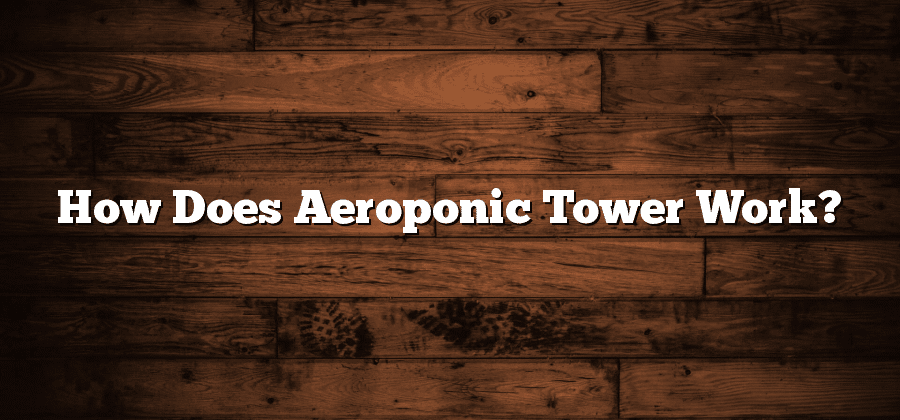What is an Aeroponic Tower?
An aeroponic tower is a revolutionary vertical gardening system that allows plants to grow without the use of soil. Instead, plants are suspended in a tower-like structure, where their roots are exposed to a fine mist of water and nutrient solutions. This groundbreaking technique provides an efficient and effective way of cultivating plants, particularly in urban environments where space is limited.
The structure of an aeroponic tower is designed to maximize plant growth and optimize space utilization. Typically made of sturdy materials such as PVC or stainless steel, the tower consists of multiple layers or levels, each containing planting pockets for the plants. The tower is tall and narrow, allowing for multiple plants to be grown vertically, thereby saving valuable ground space. The roots of the plants are exposed in the tower, enabling them to absorb nutrients and water from the fine mist that is sprayed onto them at regular intervals. By using this innovative design, aeroponic towers offer a compact and organized system for plant cultivation that can be easily integrated into both indoor and outdoor environments.
The Benefits of Aeroponic Systems
Aeroponic systems offer a range of benefits that make them highly advantageous for modern agriculture practices. One notable benefit is their ability to conserve water, which is a precious resource in many regions. Unlike traditional soil-based farming, aeroponic systems use a fraction of the water, as the nutrient solution is misted directly onto the plant roots. This results in significantly reduced water wastage, making aeroponics an eco-friendly choice.
Another remarkable advantage of aeroponic systems is the increased oxygen availability to plant roots. By suspending the plant roots in the air and misting them with nutrient-rich solutions, aeroponic towers ensure an abundant supply of oxygen to the roots. This enhanced oxygenation promotes healthy root development and fosters efficient nutrient absorption. The constant supply of oxygen also prevents root rot and other detrimental conditions, resulting in stronger and more resilient plants. Overall, aeroponic systems provide a sustainable and efficient solution for maximizing crop yields while minimizing resource consumption.
Understanding the Aeroponic Tower Structure
The structure of an aeroponic tower plays a crucial role in the success of this innovative gardening system. Designed to maximize space and promote optimal plant growth, aeroponic towers are built with precision and attention to detail.
Typically made of durable materials such as plastic or PVC, the tower consists of several layers or levels. Each level is equipped with planting cups or nets where the plants are positioned. These cups are strategically placed to provide ample space for the roots to grow and absorb nutrients efficiently. The tower structure also includes a reservoir at the bottom that holds the nutrient solution necessary for plant growth. The solution is pumped up to the top of the tower and distributed evenly through a series of misters or sprayers, ensuring that every plant receives the nutrients it needs to thrive.
The Role of Nutrient Solutions in Aeroponics
Nutrient solutions play a crucial role in the aeroponic system by providing the essential elements required for plant growth. Unlike traditional soil-based agriculture, where minerals are absorbed through the root system, aeroponics relies on delivering nutrients directly to the plant roots through a misting process. This method ensures that plants receive a controlled and balanced supply of nutrients, allowing them to thrive in a soilless environment.
In an aeroponic tower, the nutrient solution is carefully formulated to contain all the necessary macro and micronutrients required by the plants. These solutions are often made up of a mixture of water and concentrated nutrient blends, tailored to suit the specific needs of different plant varieties. The nutrient solutions are typically circulated through the system via pumps and distributed to the plant roots through misting nozzles or a fine spray. This precise delivery system guarantees optimal nutrient absorption by the plant roots, promoting healthy growth and development.
Stay tuned for the upcoming sections, where we will delve deeper into the fascinating world of aeroponic systems and explore how they provide oxygen to plant roots.
How Does an Aeroponic Tower Provide Oxygen to Plant Roots?
The efficient delivery of oxygen to plant roots is a crucial aspect of any successful aeroponic system. In an aeroponic tower, the oxygen supply is facilitated through a process called misting. Mist nozzles are strategically placed within the tower to create a fine spray of nutrient solution, which coats the plant roots. This misting action provides a continuous supply of oxygen to the roots, ensuring optimal oxygenation for growth and development.
Unlike conventional soil-based cultivation methods, where oxygen levels can vary, aeroponic systems are designed to provide a constant and regulated supply of oxygen. By continuously misting the roots with nutrient solution, an aeroponic tower creates a high humidity environment that promotes ample oxygen absorption. This increased oxygen availability leads to faster and more efficient nutrient uptake, promoting healthier plant growth and minimizing the risk of root diseases and deficiencies.
In addition to oxygenation, the misting action also helps to regulate the temperature around the roots. As the mist evaporates, it cools the surrounding air, maintaining favorable root temperatures even in hot climates. This ability to maintain optimal oxygen levels and temperature control is one of the key advantages of using an aeroponic tower for plant cultivation, ensuring the provision of a conducive environment for healthy and thriving plants.






